Taxation Law Assignment: Income, Deductions, and Tax Implications
VerifiedAdded on 2020/05/16
|11
|1854
|45
Homework Assignment
AI Summary
This assignment analyzes the taxation law implications for Bridget, focusing on her income from various sources like salaries, rent, and prizes, and the associated deductions. The analysis references specific sections of the ITAA 1997, such as sections 6-5 and 8-1, to determine assessable income and allowable deductions. The assignment examines the tax treatment of income from personal exertion, including wages, salaries, and fringe benefits, as well as rental income. It also addresses the taxability of prize winnings and payments for surrendering rights, referencing relevant case law like Calvert v Wainwright (1937) and Moore v Griffiths (1972). Furthermore, the assignment considers deductions for self-education expenses and work-related clothing, citing cases like FCT v Studdert (1991) and Mansfield v FCT (1996). The application section applies these principles to Bridget's specific circumstances, calculating her assessable income, deductions, and overall tax liability. Finally, the document provides a comprehensive list of references including books and case laws used to support the analysis.
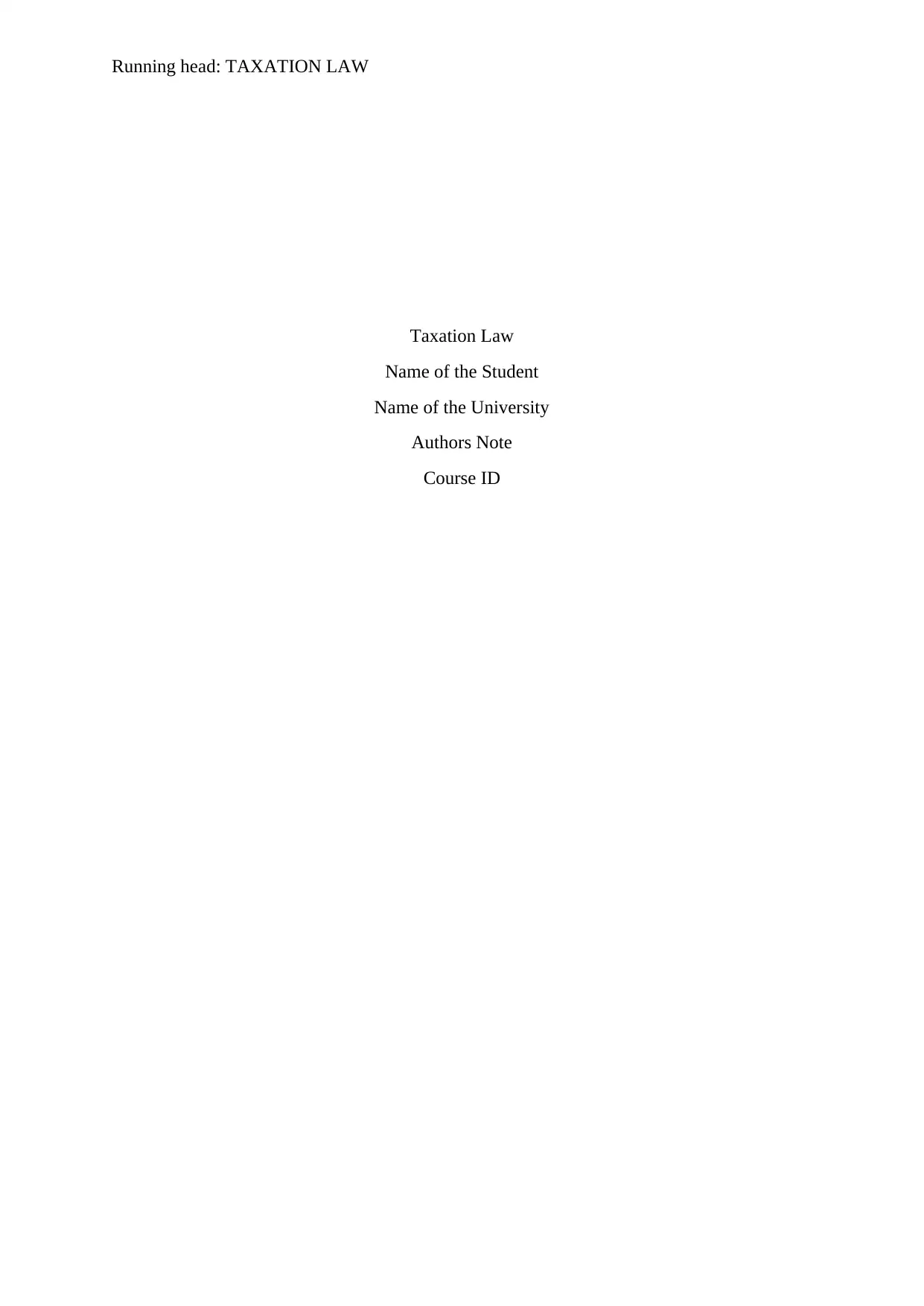
Running head: TAXATION LAW
Taxation Law
Name of the Student
Name of the University
Authors Note
Course ID
Taxation Law
Name of the Student
Name of the University
Authors Note
Course ID
Paraphrase This Document
Need a fresh take? Get an instant paraphrase of this document with our AI Paraphraser
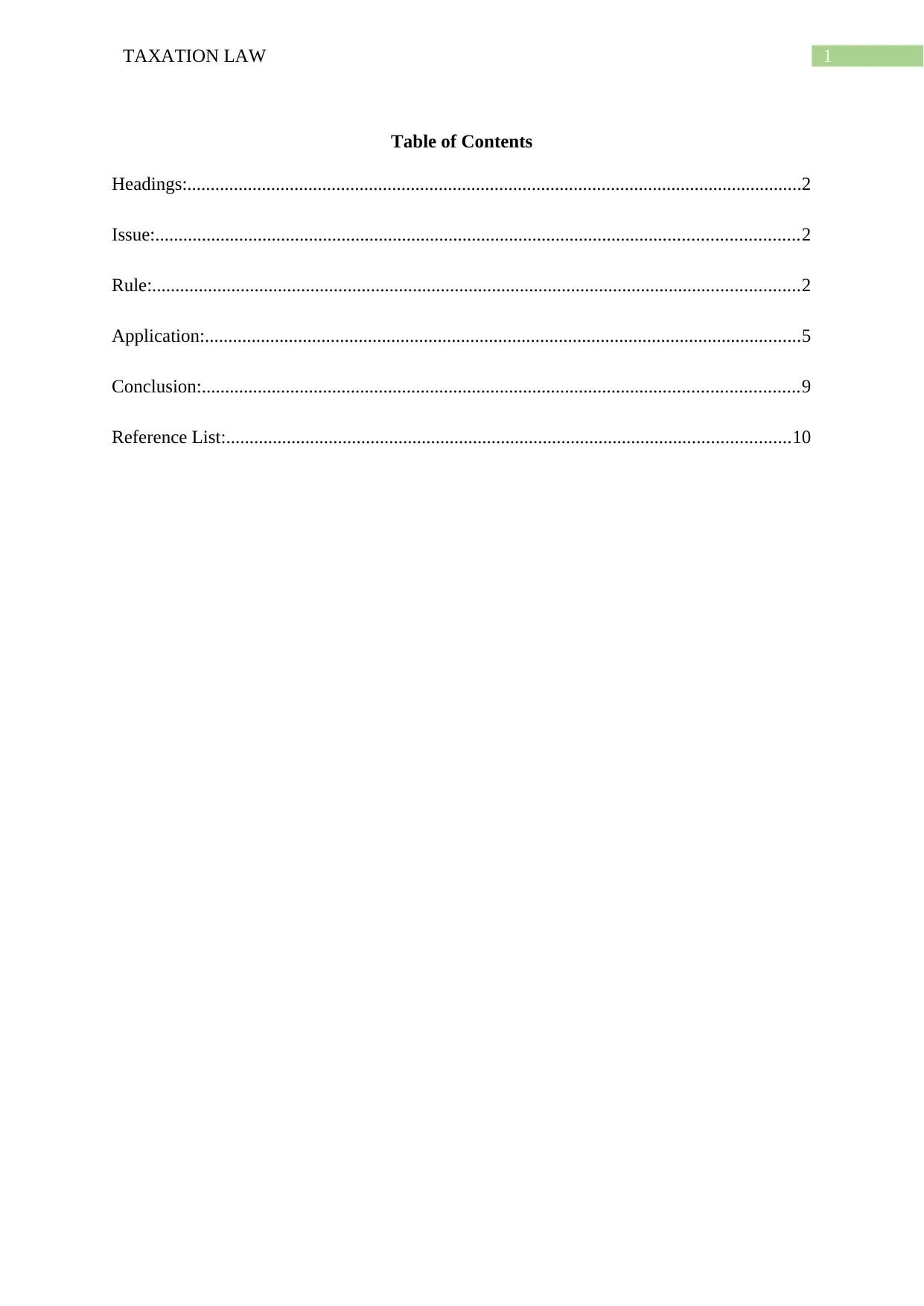
1TAXATION LAW
Table of Contents
Headings:....................................................................................................................................2
Issue:..........................................................................................................................................2
Rule:...........................................................................................................................................2
Application:................................................................................................................................5
Conclusion:................................................................................................................................9
Reference List:.........................................................................................................................10
Table of Contents
Headings:....................................................................................................................................2
Issue:..........................................................................................................................................2
Rule:...........................................................................................................................................2
Application:................................................................................................................................5
Conclusion:................................................................................................................................9
Reference List:.........................................................................................................................10
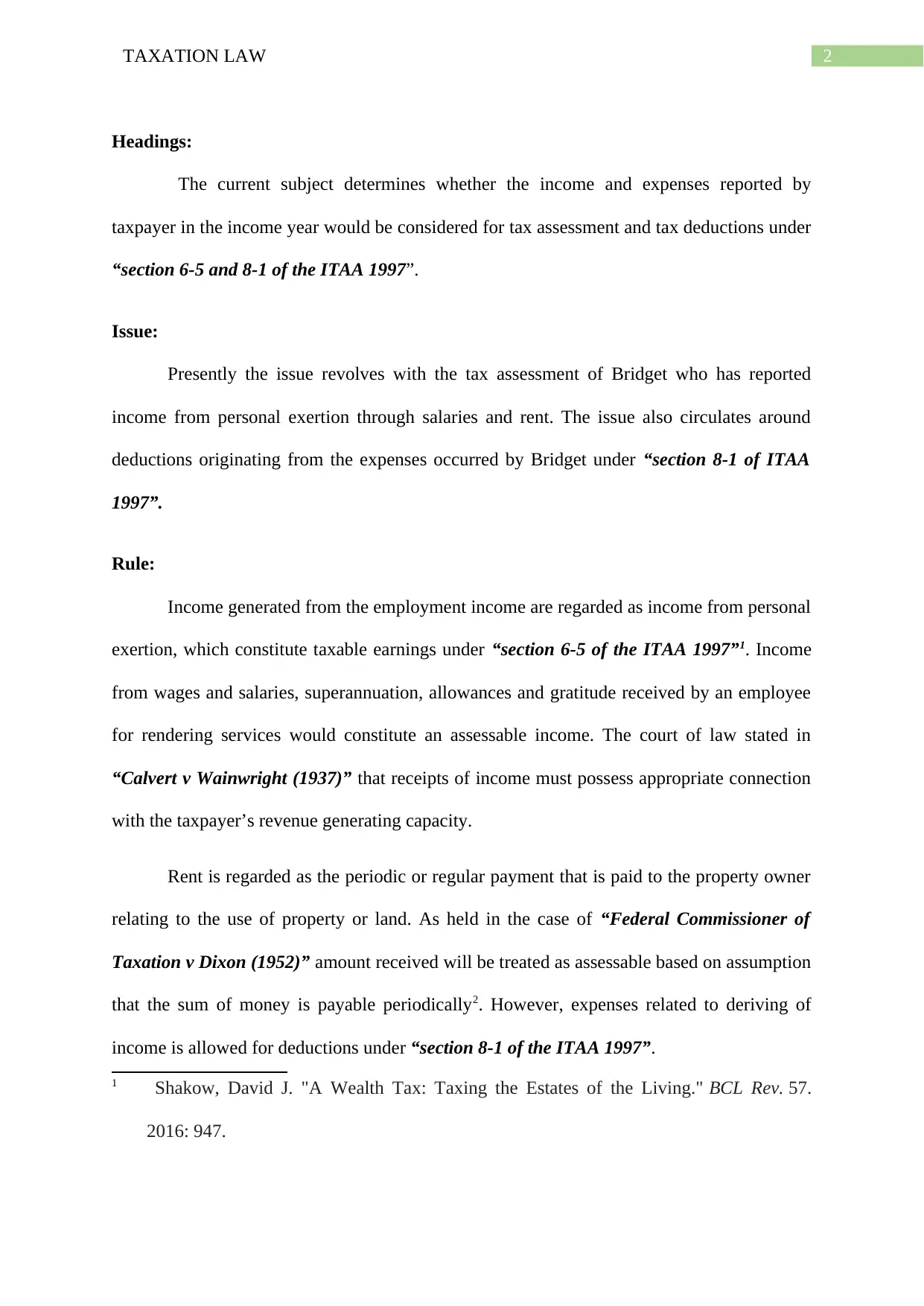
2TAXATION LAW
Headings:
The current subject determines whether the income and expenses reported by
taxpayer in the income year would be considered for tax assessment and tax deductions under
“section 6-5 and 8-1 of the ITAA 1997”.
Issue:
Presently the issue revolves with the tax assessment of Bridget who has reported
income from personal exertion through salaries and rent. The issue also circulates around
deductions originating from the expenses occurred by Bridget under “section 8-1 of ITAA
1997”.
Rule:
Income generated from the employment income are regarded as income from personal
exertion, which constitute taxable earnings under “section 6-5 of the ITAA 1997”1. Income
from wages and salaries, superannuation, allowances and gratitude received by an employee
for rendering services would constitute an assessable income. The court of law stated in
“Calvert v Wainwright (1937)” that receipts of income must possess appropriate connection
with the taxpayer’s revenue generating capacity.
Rent is regarded as the periodic or regular payment that is paid to the property owner
relating to the use of property or land. As held in the case of “Federal Commissioner of
Taxation v Dixon (1952)” amount received will be treated as assessable based on assumption
that the sum of money is payable periodically2. However, expenses related to deriving of
income is allowed for deductions under “section 8-1 of the ITAA 1997”.
1 Shakow, David J. "A Wealth Tax: Taxing the Estates of the Living." BCL Rev. 57.
2016: 947.
Headings:
The current subject determines whether the income and expenses reported by
taxpayer in the income year would be considered for tax assessment and tax deductions under
“section 6-5 and 8-1 of the ITAA 1997”.
Issue:
Presently the issue revolves with the tax assessment of Bridget who has reported
income from personal exertion through salaries and rent. The issue also circulates around
deductions originating from the expenses occurred by Bridget under “section 8-1 of ITAA
1997”.
Rule:
Income generated from the employment income are regarded as income from personal
exertion, which constitute taxable earnings under “section 6-5 of the ITAA 1997”1. Income
from wages and salaries, superannuation, allowances and gratitude received by an employee
for rendering services would constitute an assessable income. The court of law stated in
“Calvert v Wainwright (1937)” that receipts of income must possess appropriate connection
with the taxpayer’s revenue generating capacity.
Rent is regarded as the periodic or regular payment that is paid to the property owner
relating to the use of property or land. As held in the case of “Federal Commissioner of
Taxation v Dixon (1952)” amount received will be treated as assessable based on assumption
that the sum of money is payable periodically2. However, expenses related to deriving of
income is allowed for deductions under “section 8-1 of the ITAA 1997”.
1 Shakow, David J. "A Wealth Tax: Taxing the Estates of the Living." BCL Rev. 57.
2016: 947.
⊘ This is a preview!⊘
Do you want full access?
Subscribe today to unlock all pages.

Trusted by 1+ million students worldwide
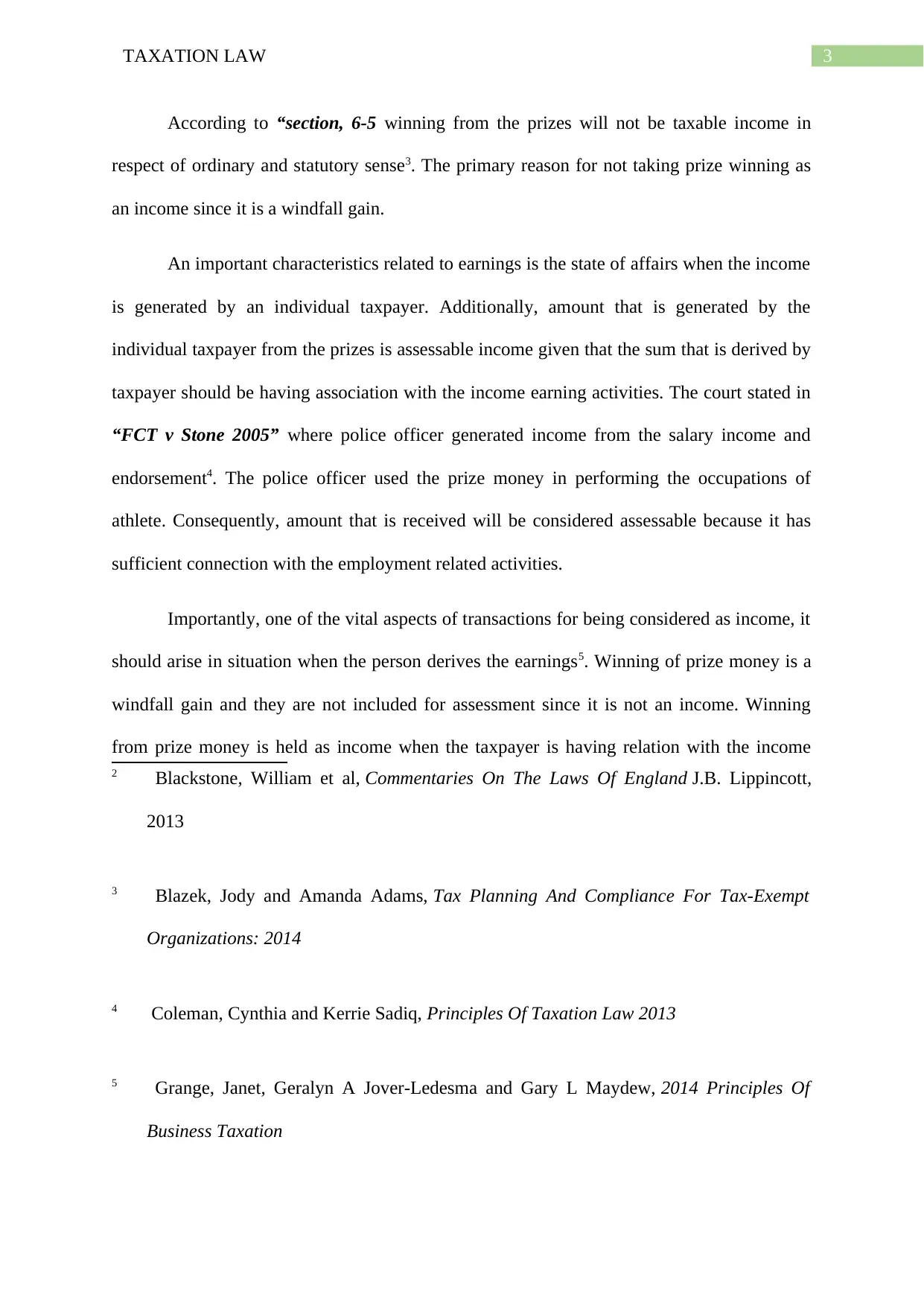
3TAXATION LAW
According to “section, 6-5 winning from the prizes will not be taxable income in
respect of ordinary and statutory sense3. The primary reason for not taking prize winning as
an income since it is a windfall gain.
An important characteristics related to earnings is the state of affairs when the income
is generated by an individual taxpayer. Additionally, amount that is generated by the
individual taxpayer from the prizes is assessable income given that the sum that is derived by
taxpayer should be having association with the income earning activities. The court stated in
“FCT v Stone 2005” where police officer generated income from the salary income and
endorsement4. The police officer used the prize money in performing the occupations of
athlete. Consequently, amount that is received will be considered assessable because it has
sufficient connection with the employment related activities.
Importantly, one of the vital aspects of transactions for being considered as income, it
should arise in situation when the person derives the earnings5. Winning of prize money is a
windfall gain and they are not included for assessment since it is not an income. Winning
from prize money is held as income when the taxpayer is having relation with the income
2 Blackstone, William et al, Commentaries On The Laws Of England J.B. Lippincott,
2013
3 Blazek, Jody and Amanda Adams, Tax Planning And Compliance For Tax-Exempt
Organizations: 2014
4 Coleman, Cynthia and Kerrie Sadiq, Principles Of Taxation Law 2013
5 Grange, Janet, Geralyn A Jover-Ledesma and Gary L Maydew, 2014 Principles Of
Business Taxation
According to “section, 6-5 winning from the prizes will not be taxable income in
respect of ordinary and statutory sense3. The primary reason for not taking prize winning as
an income since it is a windfall gain.
An important characteristics related to earnings is the state of affairs when the income
is generated by an individual taxpayer. Additionally, amount that is generated by the
individual taxpayer from the prizes is assessable income given that the sum that is derived by
taxpayer should be having association with the income earning activities. The court stated in
“FCT v Stone 2005” where police officer generated income from the salary income and
endorsement4. The police officer used the prize money in performing the occupations of
athlete. Consequently, amount that is received will be considered assessable because it has
sufficient connection with the employment related activities.
Importantly, one of the vital aspects of transactions for being considered as income, it
should arise in situation when the person derives the earnings5. Winning of prize money is a
windfall gain and they are not included for assessment since it is not an income. Winning
from prize money is held as income when the taxpayer is having relation with the income
2 Blackstone, William et al, Commentaries On The Laws Of England J.B. Lippincott,
2013
3 Blazek, Jody and Amanda Adams, Tax Planning And Compliance For Tax-Exempt
Organizations: 2014
4 Coleman, Cynthia and Kerrie Sadiq, Principles Of Taxation Law 2013
5 Grange, Janet, Geralyn A Jover-Ledesma and Gary L Maydew, 2014 Principles Of
Business Taxation
Paraphrase This Document
Need a fresh take? Get an instant paraphrase of this document with our AI Paraphraser
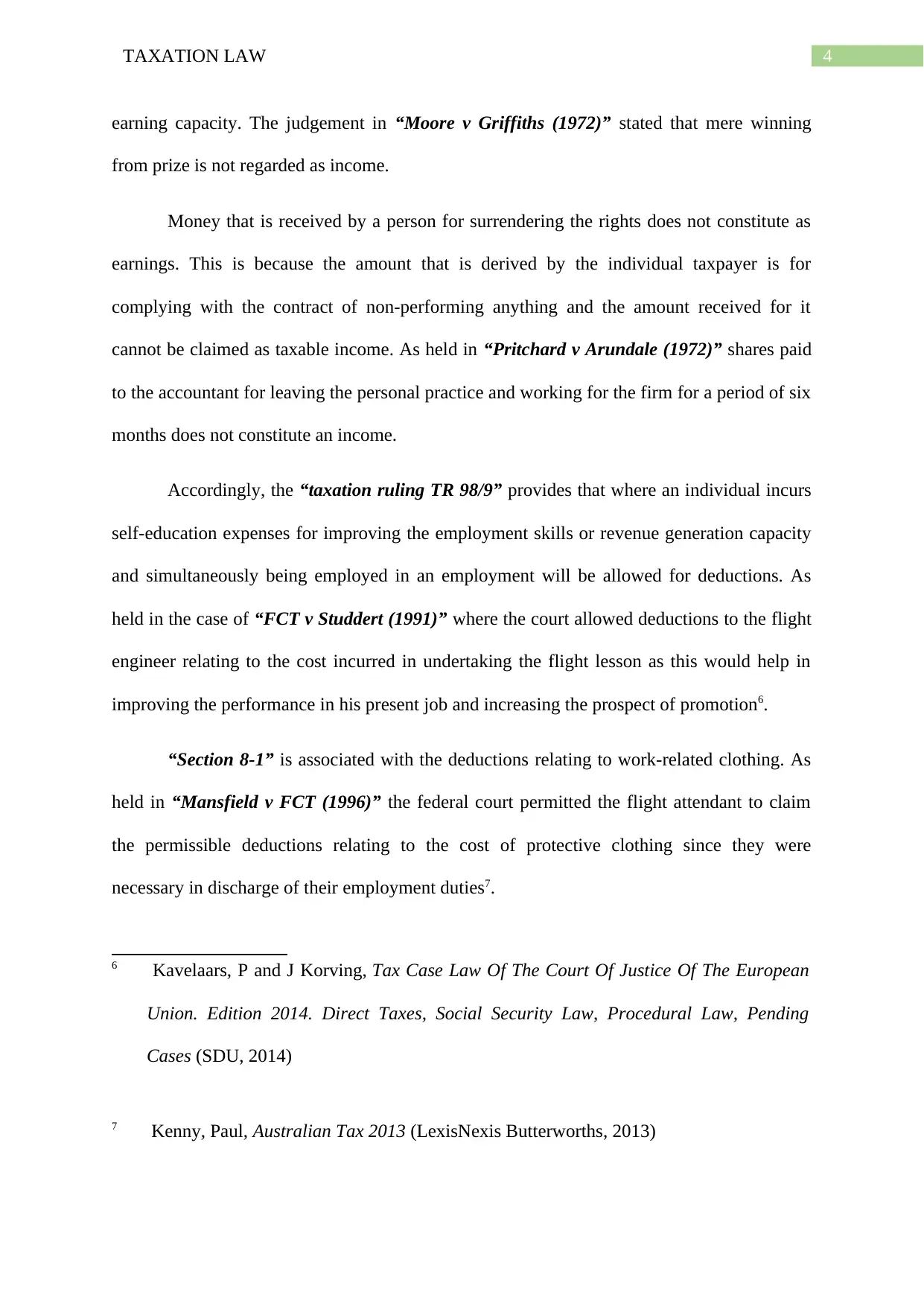
4TAXATION LAW
earning capacity. The judgement in “Moore v Griffiths (1972)” stated that mere winning
from prize is not regarded as income.
Money that is received by a person for surrendering the rights does not constitute as
earnings. This is because the amount that is derived by the individual taxpayer is for
complying with the contract of non-performing anything and the amount received for it
cannot be claimed as taxable income. As held in “Pritchard v Arundale (1972)” shares paid
to the accountant for leaving the personal practice and working for the firm for a period of six
months does not constitute an income.
Accordingly, the “taxation ruling TR 98/9” provides that where an individual incurs
self-education expenses for improving the employment skills or revenue generation capacity
and simultaneously being employed in an employment will be allowed for deductions. As
held in the case of “FCT v Studdert (1991)” where the court allowed deductions to the flight
engineer relating to the cost incurred in undertaking the flight lesson as this would help in
improving the performance in his present job and increasing the prospect of promotion6.
“Section 8-1” is associated with the deductions relating to work-related clothing. As
held in “Mansfield v FCT (1996)” the federal court permitted the flight attendant to claim
the permissible deductions relating to the cost of protective clothing since they were
necessary in discharge of their employment duties7.
6 Kavelaars, P and J Korving, Tax Case Law Of The Court Of Justice Of The European
Union. Edition 2014. Direct Taxes, Social Security Law, Procedural Law, Pending
Cases (SDU, 2014)
7 Kenny, Paul, Australian Tax 2013 (LexisNexis Butterworths, 2013)
earning capacity. The judgement in “Moore v Griffiths (1972)” stated that mere winning
from prize is not regarded as income.
Money that is received by a person for surrendering the rights does not constitute as
earnings. This is because the amount that is derived by the individual taxpayer is for
complying with the contract of non-performing anything and the amount received for it
cannot be claimed as taxable income. As held in “Pritchard v Arundale (1972)” shares paid
to the accountant for leaving the personal practice and working for the firm for a period of six
months does not constitute an income.
Accordingly, the “taxation ruling TR 98/9” provides that where an individual incurs
self-education expenses for improving the employment skills or revenue generation capacity
and simultaneously being employed in an employment will be allowed for deductions. As
held in the case of “FCT v Studdert (1991)” where the court allowed deductions to the flight
engineer relating to the cost incurred in undertaking the flight lesson as this would help in
improving the performance in his present job and increasing the prospect of promotion6.
“Section 8-1” is associated with the deductions relating to work-related clothing. As
held in “Mansfield v FCT (1996)” the federal court permitted the flight attendant to claim
the permissible deductions relating to the cost of protective clothing since they were
necessary in discharge of their employment duties7.
6 Kavelaars, P and J Korving, Tax Case Law Of The Court Of Justice Of The European
Union. Edition 2014. Direct Taxes, Social Security Law, Procedural Law, Pending
Cases (SDU, 2014)
7 Kenny, Paul, Australian Tax 2013 (LexisNexis Butterworths, 2013)
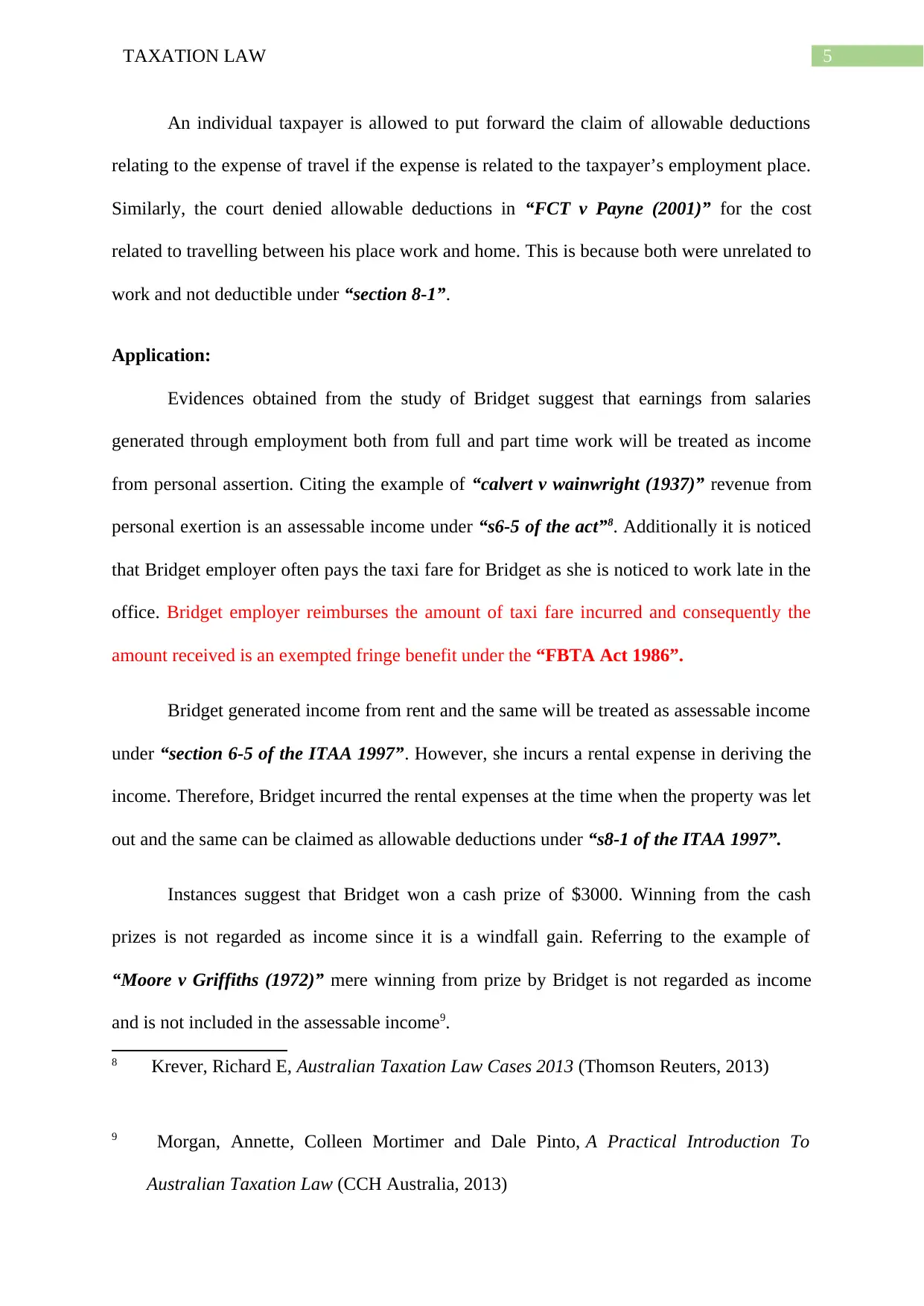
5TAXATION LAW
An individual taxpayer is allowed to put forward the claim of allowable deductions
relating to the expense of travel if the expense is related to the taxpayer’s employment place.
Similarly, the court denied allowable deductions in “FCT v Payne (2001)” for the cost
related to travelling between his place work and home. This is because both were unrelated to
work and not deductible under “section 8-1”.
Application:
Evidences obtained from the study of Bridget suggest that earnings from salaries
generated through employment both from full and part time work will be treated as income
from personal assertion. Citing the example of “calvert v wainwright (1937)” revenue from
personal exertion is an assessable income under “s6-5 of the act”8. Additionally it is noticed
that Bridget employer often pays the taxi fare for Bridget as she is noticed to work late in the
office. Bridget employer reimburses the amount of taxi fare incurred and consequently the
amount received is an exempted fringe benefit under the “FBTA Act 1986”.
Bridget generated income from rent and the same will be treated as assessable income
under “section 6-5 of the ITAA 1997”. However, she incurs a rental expense in deriving the
income. Therefore, Bridget incurred the rental expenses at the time when the property was let
out and the same can be claimed as allowable deductions under “s8-1 of the ITAA 1997”.
Instances suggest that Bridget won a cash prize of $3000. Winning from the cash
prizes is not regarded as income since it is a windfall gain. Referring to the example of
“Moore v Griffiths (1972)” mere winning from prize by Bridget is not regarded as income
and is not included in the assessable income9.
8 Krever, Richard E, Australian Taxation Law Cases 2013 (Thomson Reuters, 2013)
9 Morgan, Annette, Colleen Mortimer and Dale Pinto, A Practical Introduction To
Australian Taxation Law (CCH Australia, 2013)
An individual taxpayer is allowed to put forward the claim of allowable deductions
relating to the expense of travel if the expense is related to the taxpayer’s employment place.
Similarly, the court denied allowable deductions in “FCT v Payne (2001)” for the cost
related to travelling between his place work and home. This is because both were unrelated to
work and not deductible under “section 8-1”.
Application:
Evidences obtained from the study of Bridget suggest that earnings from salaries
generated through employment both from full and part time work will be treated as income
from personal assertion. Citing the example of “calvert v wainwright (1937)” revenue from
personal exertion is an assessable income under “s6-5 of the act”8. Additionally it is noticed
that Bridget employer often pays the taxi fare for Bridget as she is noticed to work late in the
office. Bridget employer reimburses the amount of taxi fare incurred and consequently the
amount received is an exempted fringe benefit under the “FBTA Act 1986”.
Bridget generated income from rent and the same will be treated as assessable income
under “section 6-5 of the ITAA 1997”. However, she incurs a rental expense in deriving the
income. Therefore, Bridget incurred the rental expenses at the time when the property was let
out and the same can be claimed as allowable deductions under “s8-1 of the ITAA 1997”.
Instances suggest that Bridget won a cash prize of $3000. Winning from the cash
prizes is not regarded as income since it is a windfall gain. Referring to the example of
“Moore v Griffiths (1972)” mere winning from prize by Bridget is not regarded as income
and is not included in the assessable income9.
8 Krever, Richard E, Australian Taxation Law Cases 2013 (Thomson Reuters, 2013)
9 Morgan, Annette, Colleen Mortimer and Dale Pinto, A Practical Introduction To
Australian Taxation Law (CCH Australia, 2013)
⊘ This is a preview!⊘
Do you want full access?
Subscribe today to unlock all pages.

Trusted by 1+ million students worldwide
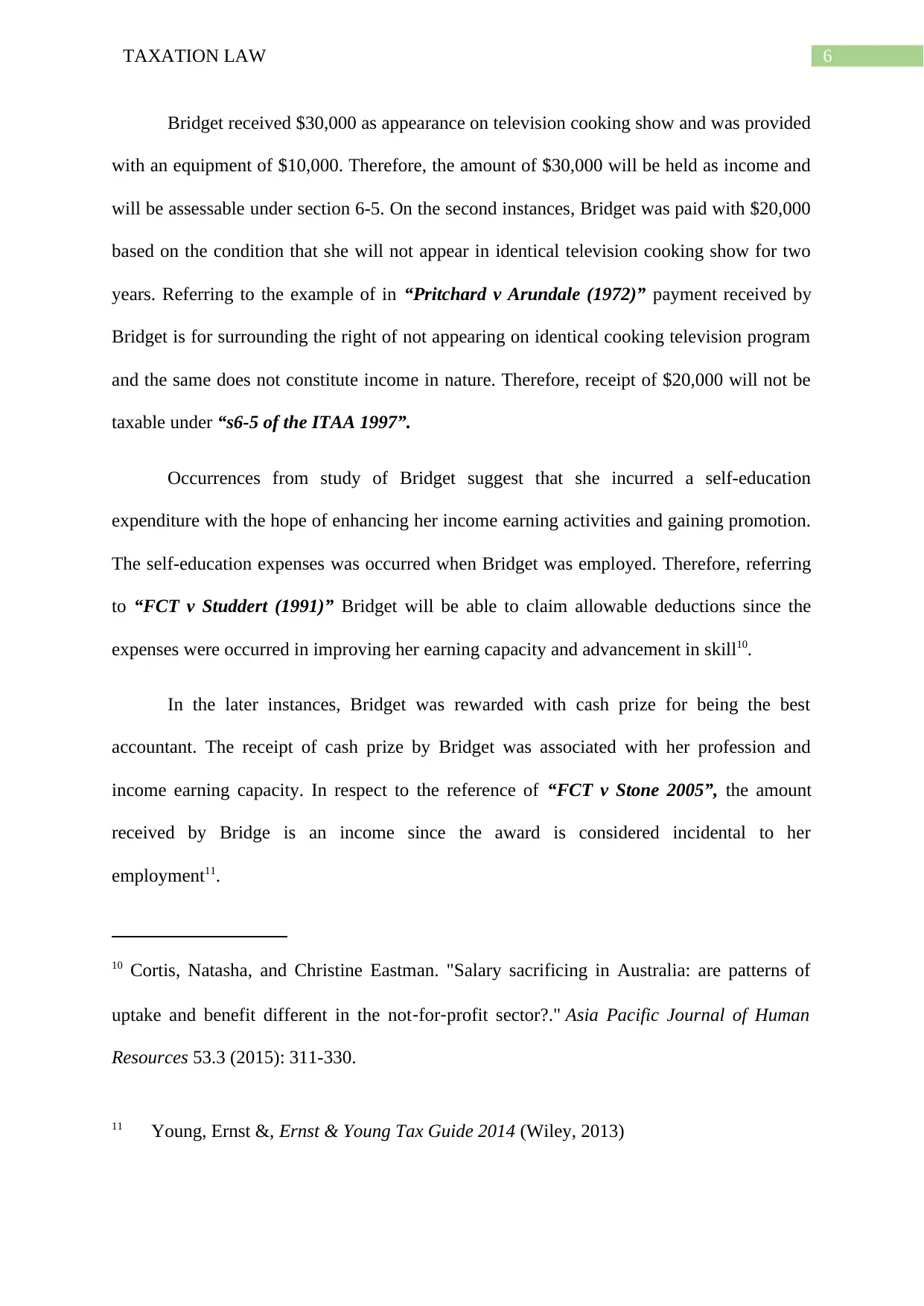
6TAXATION LAW
Bridget received $30,000 as appearance on television cooking show and was provided
with an equipment of $10,000. Therefore, the amount of $30,000 will be held as income and
will be assessable under section 6-5. On the second instances, Bridget was paid with $20,000
based on the condition that she will not appear in identical television cooking show for two
years. Referring to the example of in “Pritchard v Arundale (1972)” payment received by
Bridget is for surrounding the right of not appearing on identical cooking television program
and the same does not constitute income in nature. Therefore, receipt of $20,000 will not be
taxable under “s6-5 of the ITAA 1997”.
Occurrences from study of Bridget suggest that she incurred a self-education
expenditure with the hope of enhancing her income earning activities and gaining promotion.
The self-education expenses was occurred when Bridget was employed. Therefore, referring
to “FCT v Studdert (1991)” Bridget will be able to claim allowable deductions since the
expenses were occurred in improving her earning capacity and advancement in skill10.
In the later instances, Bridget was rewarded with cash prize for being the best
accountant. The receipt of cash prize by Bridget was associated with her profession and
income earning capacity. In respect to the reference of “FCT v Stone 2005”, the amount
received by Bridge is an income since the award is considered incidental to her
employment11.
10 Cortis, Natasha, and Christine Eastman. "Salary sacrificing in Australia: are patterns of
uptake and benefit different in the not‐for‐profit sector?." Asia Pacific Journal of Human
Resources 53.3 (2015): 311-330.
11 Young, Ernst &, Ernst & Young Tax Guide 2014 (Wiley, 2013)
Bridget received $30,000 as appearance on television cooking show and was provided
with an equipment of $10,000. Therefore, the amount of $30,000 will be held as income and
will be assessable under section 6-5. On the second instances, Bridget was paid with $20,000
based on the condition that she will not appear in identical television cooking show for two
years. Referring to the example of in “Pritchard v Arundale (1972)” payment received by
Bridget is for surrounding the right of not appearing on identical cooking television program
and the same does not constitute income in nature. Therefore, receipt of $20,000 will not be
taxable under “s6-5 of the ITAA 1997”.
Occurrences from study of Bridget suggest that she incurred a self-education
expenditure with the hope of enhancing her income earning activities and gaining promotion.
The self-education expenses was occurred when Bridget was employed. Therefore, referring
to “FCT v Studdert (1991)” Bridget will be able to claim allowable deductions since the
expenses were occurred in improving her earning capacity and advancement in skill10.
In the later instances, Bridget was rewarded with cash prize for being the best
accountant. The receipt of cash prize by Bridget was associated with her profession and
income earning capacity. In respect to the reference of “FCT v Stone 2005”, the amount
received by Bridge is an income since the award is considered incidental to her
employment11.
10 Cortis, Natasha, and Christine Eastman. "Salary sacrificing in Australia: are patterns of
uptake and benefit different in the not‐for‐profit sector?." Asia Pacific Journal of Human
Resources 53.3 (2015): 311-330.
11 Young, Ernst &, Ernst & Young Tax Guide 2014 (Wiley, 2013)
Paraphrase This Document
Need a fresh take? Get an instant paraphrase of this document with our AI Paraphraser
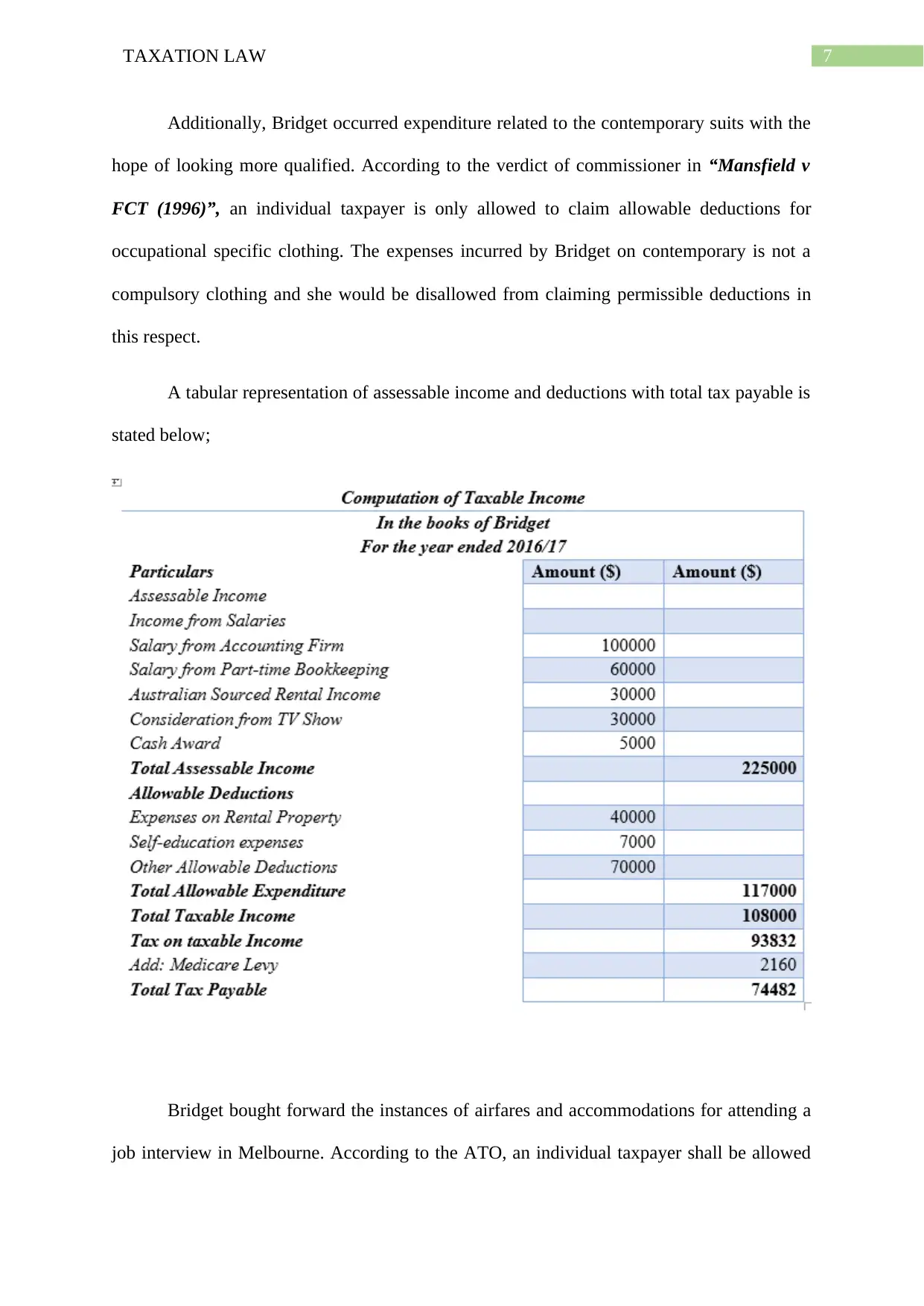
7TAXATION LAW
Additionally, Bridget occurred expenditure related to the contemporary suits with the
hope of looking more qualified. According to the verdict of commissioner in “Mansfield v
FCT (1996)”, an individual taxpayer is only allowed to claim allowable deductions for
occupational specific clothing. The expenses incurred by Bridget on contemporary is not a
compulsory clothing and she would be disallowed from claiming permissible deductions in
this respect.
A tabular representation of assessable income and deductions with total tax payable is
stated below;
Bridget bought forward the instances of airfares and accommodations for attending a
job interview in Melbourne. According to the ATO, an individual taxpayer shall be allowed
Additionally, Bridget occurred expenditure related to the contemporary suits with the
hope of looking more qualified. According to the verdict of commissioner in “Mansfield v
FCT (1996)”, an individual taxpayer is only allowed to claim allowable deductions for
occupational specific clothing. The expenses incurred by Bridget on contemporary is not a
compulsory clothing and she would be disallowed from claiming permissible deductions in
this respect.
A tabular representation of assessable income and deductions with total tax payable is
stated below;
Bridget bought forward the instances of airfares and accommodations for attending a
job interview in Melbourne. According to the ATO, an individual taxpayer shall be allowed
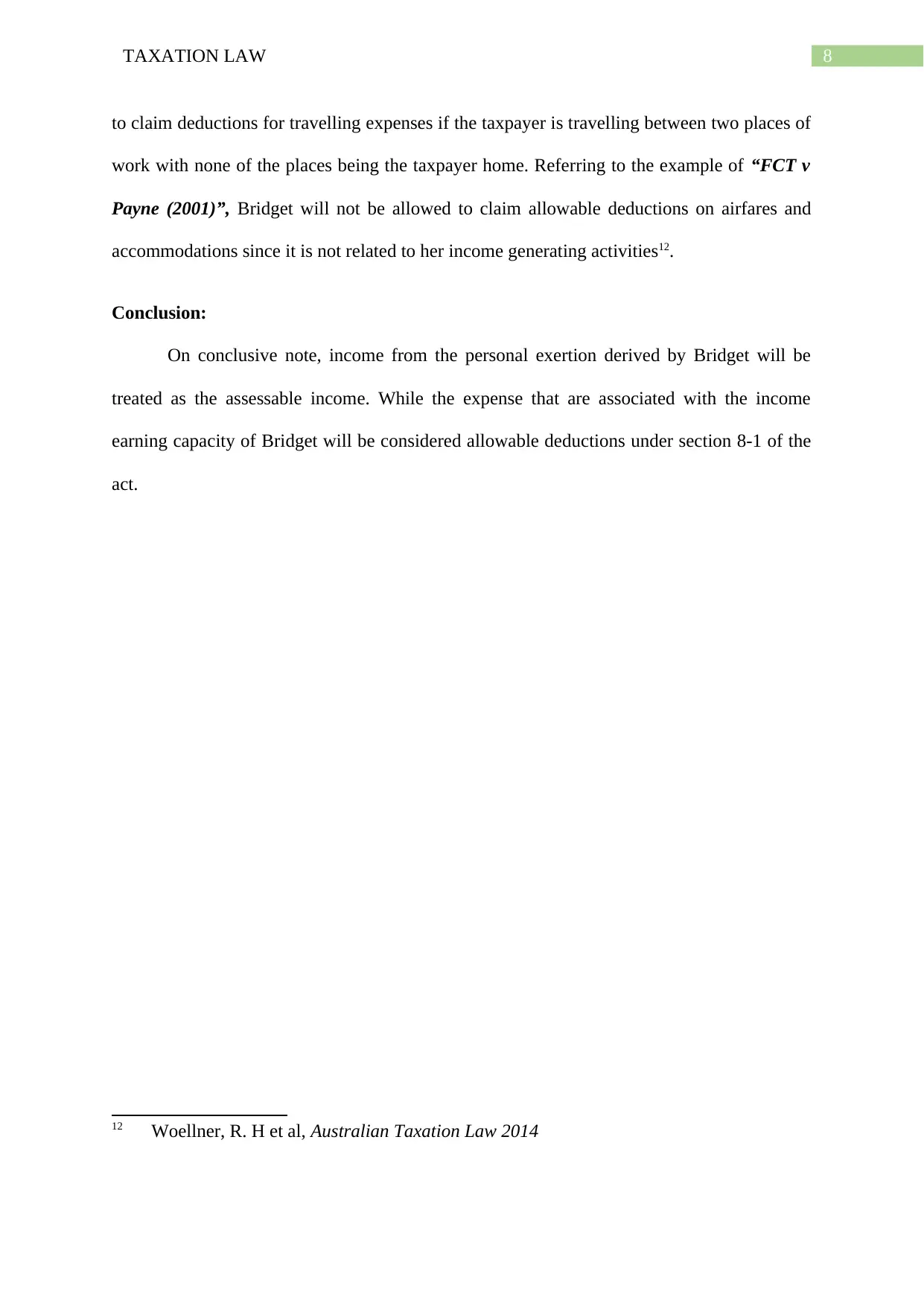
8TAXATION LAW
to claim deductions for travelling expenses if the taxpayer is travelling between two places of
work with none of the places being the taxpayer home. Referring to the example of “FCT v
Payne (2001)”, Bridget will not be allowed to claim allowable deductions on airfares and
accommodations since it is not related to her income generating activities12.
Conclusion:
On conclusive note, income from the personal exertion derived by Bridget will be
treated as the assessable income. While the expense that are associated with the income
earning capacity of Bridget will be considered allowable deductions under section 8-1 of the
act.
12 Woellner, R. H et al, Australian Taxation Law 2014
to claim deductions for travelling expenses if the taxpayer is travelling between two places of
work with none of the places being the taxpayer home. Referring to the example of “FCT v
Payne (2001)”, Bridget will not be allowed to claim allowable deductions on airfares and
accommodations since it is not related to her income generating activities12.
Conclusion:
On conclusive note, income from the personal exertion derived by Bridget will be
treated as the assessable income. While the expense that are associated with the income
earning capacity of Bridget will be considered allowable deductions under section 8-1 of the
act.
12 Woellner, R. H et al, Australian Taxation Law 2014
⊘ This is a preview!⊘
Do you want full access?
Subscribe today to unlock all pages.

Trusted by 1+ million students worldwide
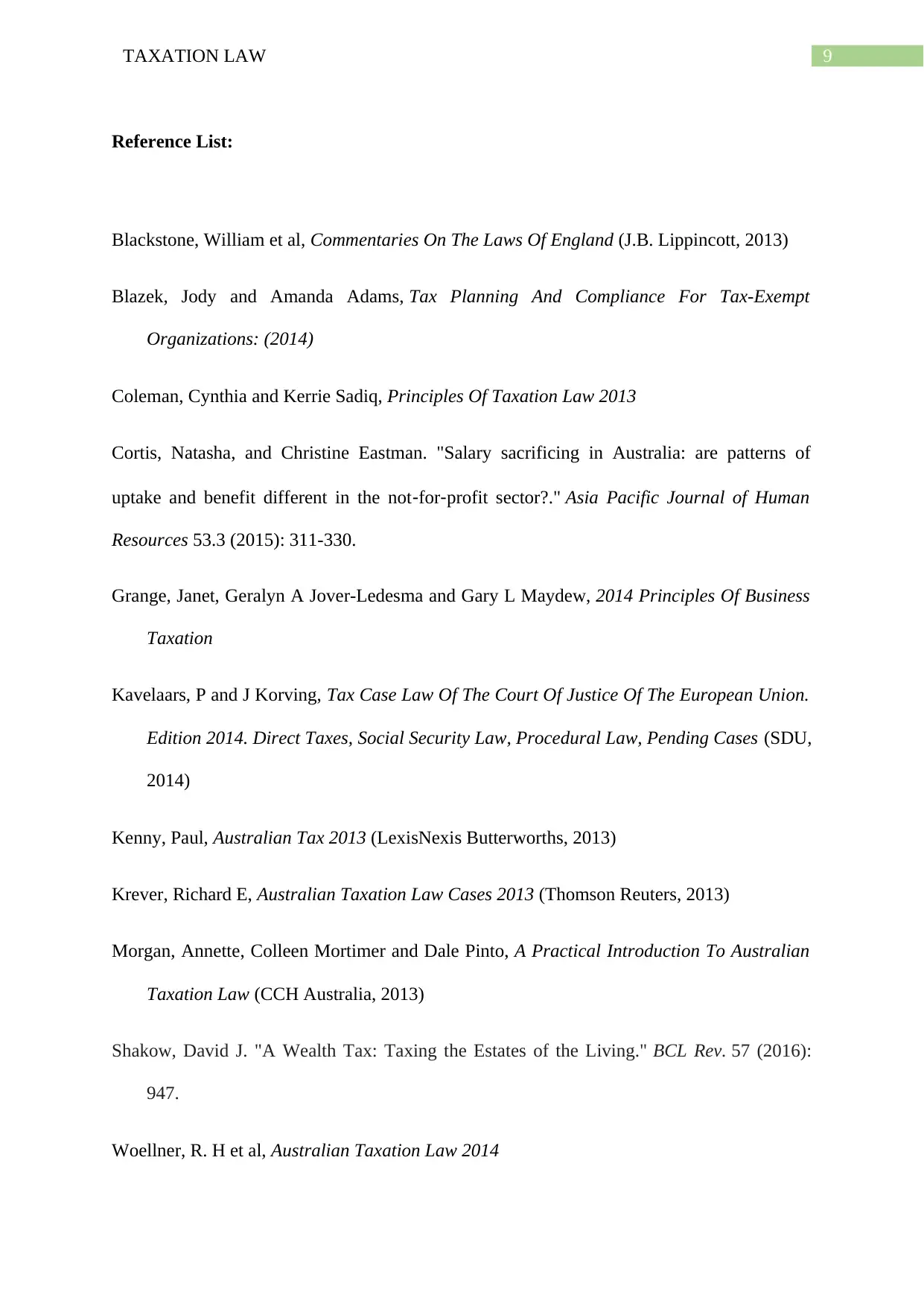
9TAXATION LAW
Reference List:
Blackstone, William et al, Commentaries On The Laws Of England (J.B. Lippincott, 2013)
Blazek, Jody and Amanda Adams, Tax Planning And Compliance For Tax-Exempt
Organizations: (2014)
Coleman, Cynthia and Kerrie Sadiq, Principles Of Taxation Law 2013
Cortis, Natasha, and Christine Eastman. "Salary sacrificing in Australia: are patterns of
uptake and benefit different in the not‐for‐profit sector?." Asia Pacific Journal of Human
Resources 53.3 (2015): 311-330.
Grange, Janet, Geralyn A Jover-Ledesma and Gary L Maydew, 2014 Principles Of Business
Taxation
Kavelaars, P and J Korving, Tax Case Law Of The Court Of Justice Of The European Union.
Edition 2014. Direct Taxes, Social Security Law, Procedural Law, Pending Cases (SDU,
2014)
Kenny, Paul, Australian Tax 2013 (LexisNexis Butterworths, 2013)
Krever, Richard E, Australian Taxation Law Cases 2013 (Thomson Reuters, 2013)
Morgan, Annette, Colleen Mortimer and Dale Pinto, A Practical Introduction To Australian
Taxation Law (CCH Australia, 2013)
Shakow, David J. "A Wealth Tax: Taxing the Estates of the Living." BCL Rev. 57 (2016):
947.
Woellner, R. H et al, Australian Taxation Law 2014
Reference List:
Blackstone, William et al, Commentaries On The Laws Of England (J.B. Lippincott, 2013)
Blazek, Jody and Amanda Adams, Tax Planning And Compliance For Tax-Exempt
Organizations: (2014)
Coleman, Cynthia and Kerrie Sadiq, Principles Of Taxation Law 2013
Cortis, Natasha, and Christine Eastman. "Salary sacrificing in Australia: are patterns of
uptake and benefit different in the not‐for‐profit sector?." Asia Pacific Journal of Human
Resources 53.3 (2015): 311-330.
Grange, Janet, Geralyn A Jover-Ledesma and Gary L Maydew, 2014 Principles Of Business
Taxation
Kavelaars, P and J Korving, Tax Case Law Of The Court Of Justice Of The European Union.
Edition 2014. Direct Taxes, Social Security Law, Procedural Law, Pending Cases (SDU,
2014)
Kenny, Paul, Australian Tax 2013 (LexisNexis Butterworths, 2013)
Krever, Richard E, Australian Taxation Law Cases 2013 (Thomson Reuters, 2013)
Morgan, Annette, Colleen Mortimer and Dale Pinto, A Practical Introduction To Australian
Taxation Law (CCH Australia, 2013)
Shakow, David J. "A Wealth Tax: Taxing the Estates of the Living." BCL Rev. 57 (2016):
947.
Woellner, R. H et al, Australian Taxation Law 2014
Paraphrase This Document
Need a fresh take? Get an instant paraphrase of this document with our AI Paraphraser
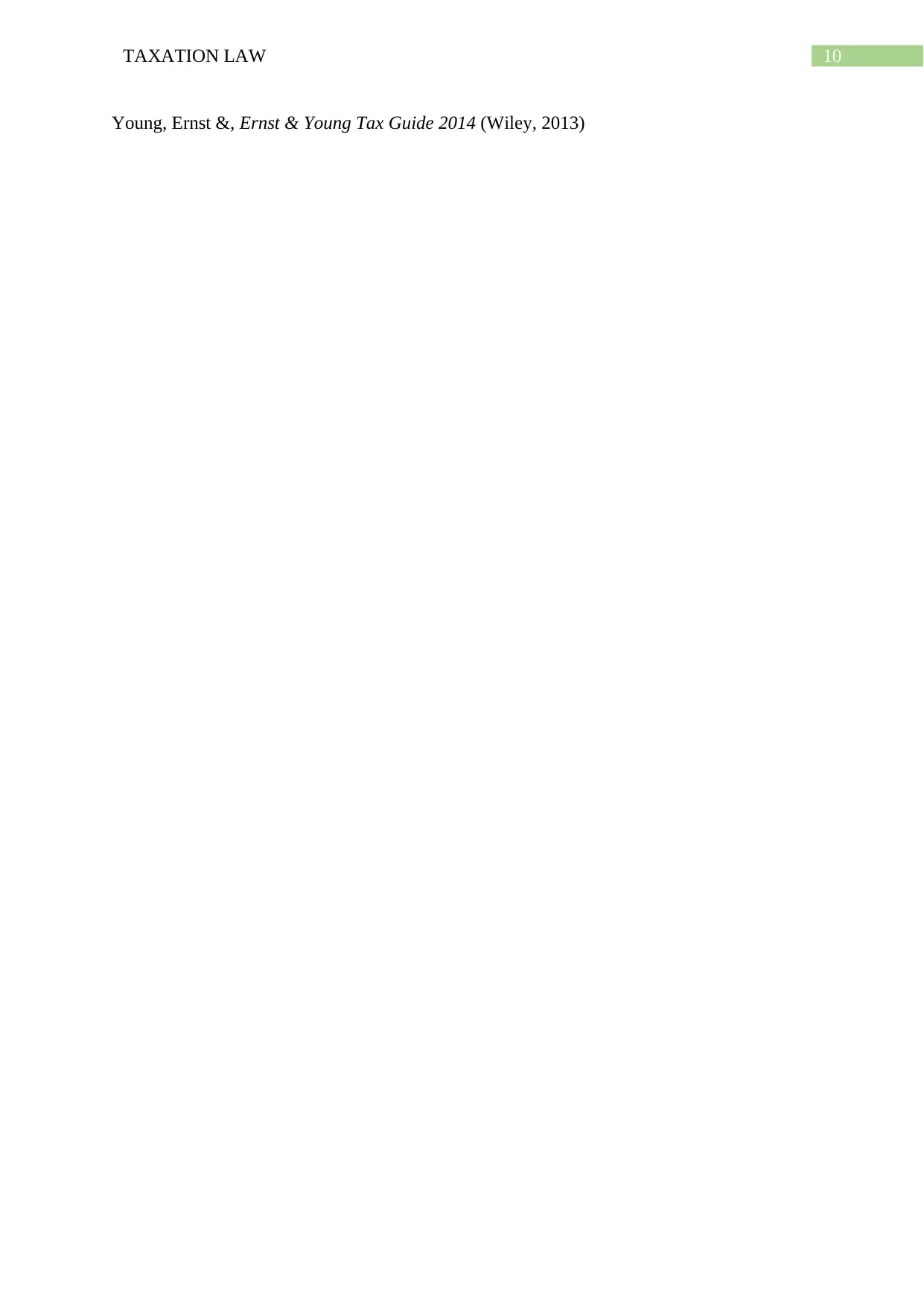
10TAXATION LAW
Young, Ernst &, Ernst & Young Tax Guide 2014 (Wiley, 2013)
Young, Ernst &, Ernst & Young Tax Guide 2014 (Wiley, 2013)
1 out of 11
Related Documents
Your All-in-One AI-Powered Toolkit for Academic Success.
+13062052269
info@desklib.com
Available 24*7 on WhatsApp / Email
![[object Object]](/_next/static/media/star-bottom.7253800d.svg)
Unlock your academic potential
Copyright © 2020–2025 A2Z Services. All Rights Reserved. Developed and managed by ZUCOL.




